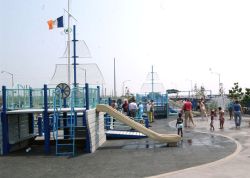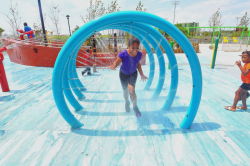Rockaway Beach and Boardwalk
Rockaway Park
The origins of the name Rockaway Peninsula is closely related to the language of the Delaware and Chippewa Native Americans. Linguistic experts recognize both “Reckonwacky,” meaning “the place of our own people,” and “Reckanawahaha,” meaning “the place of laughing waters,” as the area’s indigenous names. Following the region’s European colonization during the seventeenth century, the present name was derived from these meanings. Other interpretations include “lekau,” meaning sand, and “lechauwaak,” for fork or branch. All interpretations reflect the historic and geographic traits of the peninsula.
The Canarsie Tribe, which originally inhabited the area, sold the mostly barren land to Captain Palmer, an Englishman, with a deed granted by then Governor Thomas Dongan in 1685. Disappointed with his purchase, Palmer sold the land in 1687 to a prominent iron master from Long Island, Richard Cornell, whose descendant, Ezra, founded Cornell University in 1865.
The Cornell family owned the land until 1808, when a partition suit divided the plot into 46 parcels, which were eventually sold to outsiders. The Rockaway Association, a group of wealthy New Yorkers, bought much of the property and began to build exclusive resorts in 1833. Within two years, James Remsen bought a large portion of the Peninsula. Remsen initiated a railroad project connecting the neighborhoods of Canarsie and East New York. The new railway was intended to greet steam ferries taking passengers to and from Rockaway. The Rockaway Peninsula remained a beachfront resort town, providing hotels, restaurants, and housing for those who could afford to pay for the trip. During the 1890s, a variety of amusement parks were built. In 1897, the Village of Rockaway Park was incorporated into New York City.
Improvements in transportation, under the direction of Parks Commissioner Robert Moses in the 1930’s, led to the growth of Rockaway. The completion of two bridges, the Marine Parkway Bridge in 1937 and the Cross Bay Bridge in 1939, connected Rockaway to mainland Queens and Brooklyn. Innovations in railroad service and the development of the elevated subway allowed popular access to the peninsula. Subway access stimulated Rockaway’s transition from a vacation area to neighborhoods with permanent residents.
This section of boardwalk, named Ocean Promenade, extends from Beach 110th to Beach 126th Streets and is bounded by the Atlantic Ocean and the boardwalk itself. The width of the beach averages 500 feet in this area. The boardwalk, measuring 30 feet in diameter, runs through the neighborhood of Rockaway Park. Parks acquired the ocean front area in 1911, as a gift from the Rockaway Park Improvement Company. Previously, Ocean Promenade was known as Triton Avenue. Between 1922 and 1923, the construction of the boardwalk took place and replaced Triton Avenue. The promenade continues to be considered a city street and ends at Beach 126th Street.
Lifeguards are stationed on the beach from Memorial Day through Labor Day. Beach-goers enjoy newly added spray showers and scenic dunes. This beach area is complemented by a variety of shops and restaurants on Beach 116th Street, which is also the final stop on the A train. In 1999, for the first time in 25 years, the entire boardwalk was open to the public following a multi-million dollar restoration project.
Check out your park's Vital Signs
Clean & Safe
Green & Resilient
Empowered & Engaged Users
Share your feedback or learn more about how this park is part of a
Vital Park System










